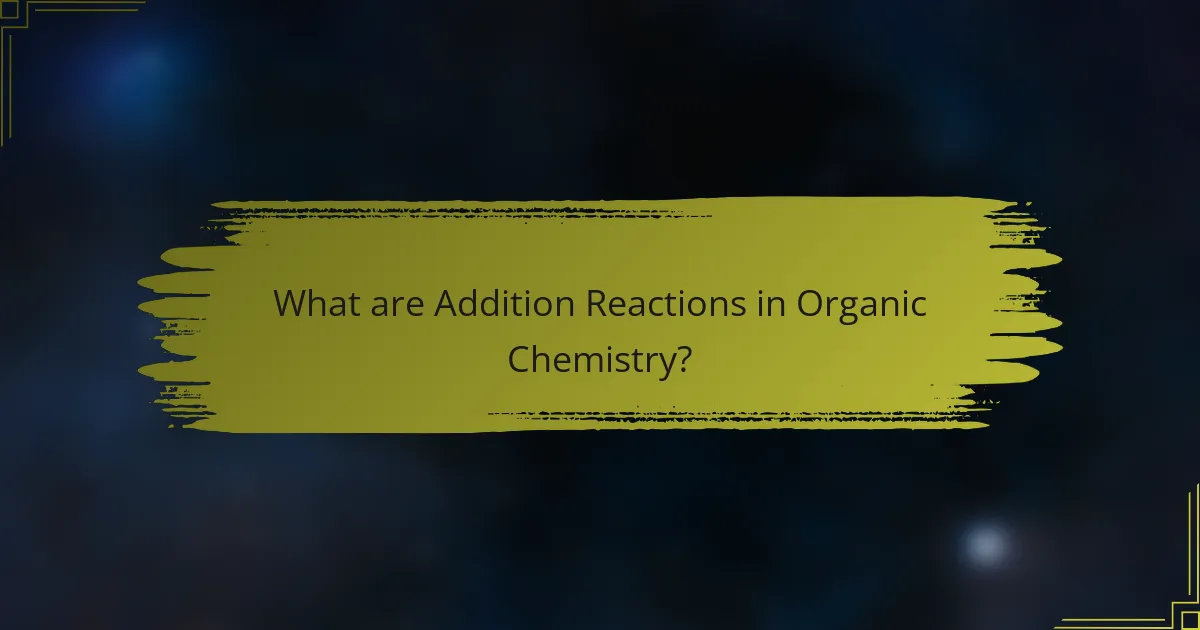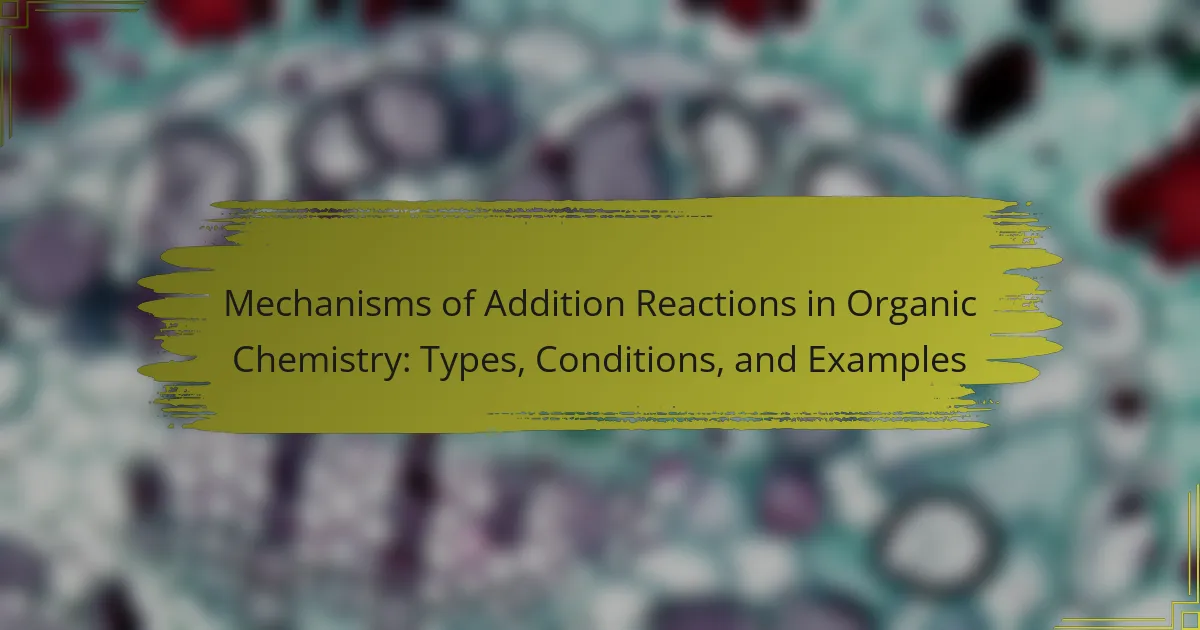
What are Addition Reactions in Organic Chemistry?
Addition reactions in organic chemistry are a type of chemical reaction where two or more reactants combine to form a single product. This process typically occurs with unsaturated compounds, such as alkenes and alkynes. During addition reactions, pi bonds are broken, allowing new sigma bonds to form. Common examples include hydrogenation, halogenation, and hydrohalogenation. Addition reactions are essential in synthesizing various organic compounds. They are widely used in the production of pharmaceuticals and petrochemicals. The mechanisms of these reactions can vary based on the conditions and reactants involved. Understanding addition reactions is crucial for organic synthesis and reaction design.
How do Addition Reactions differ from other types of reactions?
Addition reactions involve the direct combination of two or more reactants to form a single product. This distinguishes them from other reaction types, such as elimination or substitution reactions. In elimination reactions, one or more atoms or groups are removed from a molecule, resulting in the formation of a double or triple bond. Substitution reactions involve the replacement of one atom or group in a molecule with another.
Addition reactions typically occur with unsaturated compounds, such as alkenes and alkynes. They result in the saturation of the molecule, increasing its hydrogen content. For example, the addition of hydrogen to an alkene converts it into an alkane.
The mechanism of addition reactions often involves the formation of a reactive intermediate, such as a carbocation or carbanion. This is a key step that differentiates them from other reactions, which may not involve such intermediates. Overall, the defining feature of addition reactions is the formation of a single product through the combination of reactants.
What are the key characteristics of Addition Reactions?
Addition reactions involve the direct combination of two or more reactants to form a single product. These reactions typically occur with unsaturated compounds, such as alkenes and alkynes. In addition reactions, the double or triple bonds of the reactants are broken. This results in the formation of new single bonds. Addition reactions can be classified into several types, including electrophilic, nucleophilic, and radical additions. They often require specific conditions, such as the presence of catalysts or certain temperatures. The overall reaction usually leads to an increase in saturation of the reactants. Addition reactions are fundamental in organic chemistry and are widely used in the synthesis of various compounds.
Why are Addition Reactions important in organic synthesis?
Addition reactions are important in organic synthesis because they allow the formation of new carbon-carbon or carbon-heteroatom bonds. These reactions increase molecular complexity by transforming simple molecules into more complex structures. They are fundamental for creating functional groups and modifying existing ones. Addition reactions are widely used in the synthesis of pharmaceuticals, agrochemicals, and natural products. For example, the hydrogenation of alkenes converts them into alkanes, which are valuable in various applications. Furthermore, these reactions often proceed under mild conditions, making them efficient and practical for laboratory and industrial settings.
What are the main types of Addition Reactions?
The main types of addition reactions are electrophilic addition, nucleophilic addition, and radical addition. Electrophilic addition involves the attack of an electrophile on a nucleophile, commonly seen in alkenes and alkynes. Nucleophilic addition occurs when a nucleophile reacts with a carbonyl compound, such as aldehydes or ketones. Radical addition involves the addition of radicals to unsaturated compounds, often initiated by heat or light. These categories encompass various mechanisms and substrates in organic chemistry, illustrating the diversity of addition reactions.
What is the mechanism of Electrophilic Addition?
Electrophilic addition is a reaction mechanism where an electrophile reacts with a nucleophile. This process typically occurs with alkenes and alkynes. The double or triple bond acts as a nucleophile, attacking the electrophile. This results in the formation of a carbocation intermediate. The nucleophile then attacks this carbocation, leading to the formation of a saturated product. This mechanism is fundamental in organic chemistry for constructing more complex molecules. Electrophilic addition reactions are influenced by the stability of the carbocation formed. More stable carbocations lead to faster reactions, as seen in Markovnikov’s rule.
How does Nucleophilic Addition occur?
Nucleophilic addition occurs when a nucleophile attacks an electrophilic carbon atom. This reaction typically involves carbonyl compounds, such as aldehydes and ketones. The nucleophile donates a pair of electrons to the carbon atom, forming a new bond. This results in the formation of a tetrahedral intermediate. The intermediate then undergoes protonation, leading to the final product. The reaction is facilitated by the electrophilic nature of the carbonyl carbon. This mechanism is essential in organic synthesis and is widely studied in organic chemistry.
What is the role of Free Radical Addition?
Free radical addition plays a crucial role in organic chemistry by facilitating the formation of new chemical bonds. This mechanism involves the addition of free radicals to unsaturated compounds, such as alkenes or alkynes. The process typically initiates through the generation of free radicals, often from a radical initiator.
Once formed, the free radicals react with the double or triple bonds of the unsaturated compounds. This reaction leads to the creation of new radicals, which can further react to complete the addition process. Free radical addition is significant in polymerization reactions, where it helps in synthesizing polymers from monomers.
The versatility of free radical addition allows for various products depending on the starting materials and conditions. This mechanism is also essential in the production of many industrial chemicals and materials.

What conditions influence Addition Reactions?
Addition reactions are influenced by several key conditions. Temperature plays a crucial role, as higher temperatures can increase reaction rates. Pressure also impacts these reactions, particularly in gas-phase addition reactions. The presence of catalysts can significantly enhance the efficiency of addition reactions. Solvent choice affects the polarity and stability of reactants and products. Reactant concentration is another critical factor; higher concentrations typically lead to increased reaction rates. Additionally, the structure of the reactants can influence the pathway and outcome of the addition reaction. For example, steric hindrance can impede the approach of reactants. Overall, these conditions collectively determine the rate and success of addition reactions in organic chemistry.
How do temperature and pressure affect Addition Reactions?
Temperature and pressure significantly affect addition reactions by influencing reaction rates and equilibria. Higher temperatures generally increase reaction rates due to greater molecular energy and collision frequency. For example, increasing temperature can enhance the rate of hydrogenation reactions. Conversely, lower temperatures may slow these reactions.
Pressure also plays a crucial role, especially in gas-phase addition reactions. Increasing pressure typically shifts equilibria toward the side with fewer gas molecules, promoting product formation. For instance, in the addition of gases like hydrogen to alkenes, higher pressure can increase yields.
Thus, both temperature and pressure are vital parameters in optimizing addition reactions in organic chemistry.
What is the significance of solvent choice in Addition Reactions?
Solvent choice in addition reactions is significant because it influences reaction rate, selectivity, and product stability. Polar solvents can stabilize charged intermediates, enhancing reaction rates. Non-polar solvents may favor radical mechanisms, affecting selectivity. The solvent can also impact the solubility of reactants, which is crucial for reaction efficiency. For example, in nucleophilic addition reactions, a polar protic solvent can stabilize the nucleophile. Additionally, the choice of solvent can alter the equilibrium of the reaction, leading to different product distributions. Thus, understanding solvent effects is essential for optimizing addition reactions in organic chemistry.
How do catalysts impact the rate of Addition Reactions?
Catalysts increase the rate of addition reactions by lowering the activation energy. They provide an alternative pathway for the reaction to occur. This allows more reactant molecules to have sufficient energy to undergo the reaction. As a result, the reaction proceeds faster than it would without a catalyst. For instance, in hydrogenation reactions, catalysts like palladium or platinum facilitate the addition of hydrogen to alkenes. Studies show that using catalysts can significantly reduce reaction times and improve yields.
What are the common examples of Addition Reactions?
Common examples of addition reactions include hydrogenation, halogenation, and hydrohalogenation. Hydrogenation involves the addition of hydrogen to alkenes or alkynes, converting them into alkanes. Halogenation entails the addition of halogens, such as bromine or chlorine, to alkenes, resulting in dihaloalkanes. Hydrohalogenation occurs when hydrogen halides, like HCl or HBr, react with alkenes, producing alkyl halides. These reactions are fundamental in organic chemistry and are widely used in various chemical syntheses.
What are typical examples of Electrophilic Addition?
Typical examples of electrophilic addition include the addition of hydrogen halides to alkenes. In this reaction, the alkene acts as a nucleophile. The electrophile, such as HCl or HBr, adds across the double bond. Another example is the hydration of alkenes using water in the presence of an acid. This results in the formation of alcohols. Additionally, the addition of bromine or chlorine to alkenes is a common electrophilic addition. This reaction leads to the formation of vicinal dihalides. These examples illustrate the fundamental mechanisms of electrophilic addition in organic chemistry.
How do Nucleophilic Addition examples illustrate the concept?
Nucleophilic addition examples illustrate the concept by demonstrating how nucleophiles react with electrophiles. In these reactions, a nucleophile donates an electron pair to form a new covalent bond. Common examples include the addition of water to carbonyl compounds. This process results in the formation of alcohols. Another example is the reaction of Grignard reagents with carbonyls. This results in the formation of alcohols after protonation. These examples highlight the fundamental mechanism of nucleophilic attack and bond formation. They also showcase the importance of nucleophilicity and electrophilicity in organic reactions.

How can we analyze the mechanisms of Addition Reactions?
Analyzing the mechanisms of addition reactions involves understanding the step-by-step process of how reactants convert into products. This can be achieved through various methods such as experimental techniques, computational chemistry, and kinetic studies.
Experimental techniques include observing reaction intermediates using spectroscopy or chromatography. Computational chemistry allows for the modeling of reaction pathways and energy profiles. Kinetic studies provide insights into the rates of reactions and the effect of different conditions on these rates.
Each method contributes to a comprehensive understanding of the addition reaction mechanisms. For instance, spectroscopy can reveal intermediate species, while computational models can predict the most likely pathways. Kinetic data can confirm theoretical predictions by showing how reaction rates vary with different reactant concentrations.
These approaches collectively validate the proposed mechanisms and enhance our understanding of addition reactions in organic chemistry.
What are the steps involved in the mechanism of Addition Reactions?
Addition reactions typically involve three main steps: formation of a reactive intermediate, nucleophilic attack, and product formation.
In the first step, a double bond or triple bond in a reactant molecule becomes polarized. This polarization creates a reactive intermediate, often a carbocation or radical.
The second step involves a nucleophile attacking the reactive intermediate. This nucleophile donates electrons to form a new bond.
Finally, in the third step, the product is formed as the reaction completes. The double bond is converted into a single bond, resulting in a saturated compound.
These steps are fundamental to understanding addition reactions in organic chemistry.
How do intermediates form during Addition Reactions?
Intermediates form during addition reactions through the interaction of reactants that leads to transient species. In these reactions, a nucleophile attacks an electrophile, resulting in a temporary charged or neutral species. This intermediate often possesses a distinct structure compared to the original reactants. For example, in the addition of HBr to an alkene, a carbocation intermediate is formed. This carbocation is unstable and quickly reacts with a bromide ion to form the final product. The formation of intermediates is crucial for understanding the reaction pathway. Their stability and reactivity significantly influence the overall reaction mechanism.
What role do transition states play in these mechanisms?
Transition states are crucial in the mechanisms of addition reactions in organic chemistry. They represent high-energy configurations during the transformation of reactants into products. Transition states occur at the peak of the energy barrier that must be overcome for the reaction to proceed. Their formation is essential for determining the rate of a reaction. The stability of a transition state influences the overall reaction pathway. More stable transition states correspond to lower activation energies. This relationship is described by the Arrhenius equation, which links reaction rates to activation energy. Understanding transition states helps chemists predict and optimize reaction conditions.
What are some practical tips for studying Addition Reactions?
To study Addition Reactions effectively, focus on understanding the basic principles and mechanisms involved. Start by reviewing the types of Addition Reactions, such as electrophilic and nucleophilic additions. Use visual aids like reaction mechanisms and diagrams to clarify complex processes. Practice drawing reaction mechanisms to reinforce your understanding. Engage with practice problems to apply concepts and test your knowledge. Collaborate with peers for group study sessions to discuss and clarify doubts. Utilize online resources and textbooks for comprehensive explanations and examples. Regularly review your notes to reinforce retention of key concepts.
The main entity of this article is “Addition Reactions in Organic Chemistry,” which refers to a type of chemical reaction where two or more reactants combine to form a single product, primarily involving unsaturated compounds like alkenes and alkynes. The article provides a comprehensive overview of the mechanisms, types, and conditions influencing addition reactions, including electrophilic, nucleophilic, and radical additions. Key characteristics, such as the formation of reactive intermediates and the impact of temperature, pressure, and catalysts on reaction rates, are discussed. Additionally, practical examples and tips for studying these reactions are outlined, highlighting their significance in organic synthesis and various applications in pharmaceuticals and petrochemicals.
